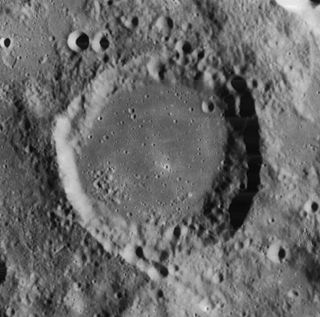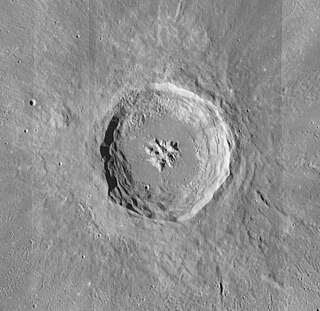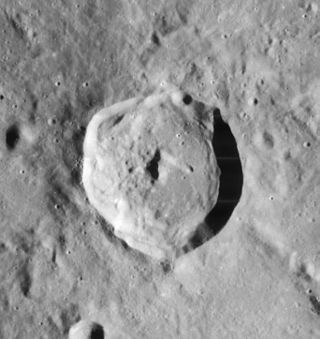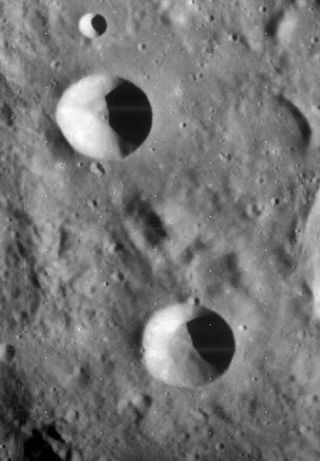
Mare Vaporum is a lunar mare located between the southwest rim of Mare Serenitatis and the southeast rim of Mare Imbrium. It was named by Giovanni Battista Riccioli in 1651.

Copernicus is a lunar impact crater located in eastern Oceanus Procellarum. It was named after the astronomer Nicolaus Copernicus. It typifies craters that formed during the Copernican period in that it has a prominent ray system. It may have been created by debris from the breakup of the parent body of asteroid 495 Eulalia 800 million years ago.

Arzachel is a relatively young lunar impact crater located in the highlands in the south-central part of the visible Moon, close to the zero meridian. It lies to the south of the crater Alphonsus, and together with Ptolemaeus further north the three form a prominent line of craters to the east of Mare Nubium. The smaller Alpetragius lies to the northwest, and Thebit is to the southwest along the edge of the mare.

Eratosthenes crater is a relatively deep lunar impact crater that lies on the boundary between the Mare Imbrium and Sinus Aestuum mare regions. It forms the western terminus of the Montes Apenninus mountain range. It is named after ancient Greek astronomer Eratosthenes of Cyrene, who estimated the circumference of the Earth, and the distance from the Earth to the Sun.

Horrocks is a lunar impact crater located entirely within the eroded northeast rim of the much larger walled plain Hipparchus. Its diameter is 30 km. It was named after the 17th-century English astronomer Jeremiah Horrocks. To the south of Horrocks are the craters Halley and Hind, Rhaeticus is to the north, and Pickering to the northeast. Gyldén and Saunder lie to the west and east, respectively.

Abulfeda is a lunar impact crater located in the central highlands of the Moon. To the northeast is the crater Descartes, and to the south-southeast is Almanon. To the north is the crater Dollond. A chain of craters named the Catena Abulfeda runs between the southern rim of Abulfeda and the north rim of Almanon, then continues for a length of 210 kilometers across the Rupes Altai. The crater was named for 14th century Kurdish historian Ismael Abul-fida.

Arago is a lunar impact crater located in the western part of the Mare Tranquillitatis. It was named after French astronomer François Arago in 1935. Its diameter is 26 km. To the southwest lies the crater Manners, and beyond are Dionysius and the Ritter–Sabine crater pair. To the southeast is the large Lamont formation that has been submerged by the mare.

Aristillus is a prominent lunar impact crater that lies in the eastern Mare Imbrium. It was named after Greek astronomer Aristyllus. Directly to the south is the smaller crater Autolycus, while to the southwest is the large Archimedes. To the northeast are the craters Theaetetus and Cassini.

Dionysius is a lunar impact crater that lies on the western edge of the Mare Tranquillitatis. It was named after Dionysius the Areopagite. To the southeast is the crater pair of Ritter and Sabine. Just to the northwest is the system of rilles designated Rimae Ritter. These clefts follow a generally northwest direction.

Julius Caesar is a lava-flooded lunar impact crater with a low, irregular, and heavily worn wall. Its diameter is 85 km. It was named after Roman statesman Julius Caesar. It is located to the west of Mare Tranquillitatis, and directly southeast of the crater Manilius on the Mare Vaporum. To the east is the rounded Sosigenes.

Sosigenes is a lunar impact crater on the west edge of Mare Tranquillitatis. Its diameter is 17 km. It was named after ancient Greek astronomer Sosigenes of Alexandria. It lies to the east of the large walled plain Julius Caesar. The crater rim has a high albedo, making it relatively bright. It has a small central rise at the midpoint of the floor.

Sulpicius Gallus is a small, bowl-shaped lunar impact crater that lies near the southwestern edge of the Mare Serenitatis. The crater is named after the 2nd century BC Roman astronomer Gaius Sulpicius Gallus.

Agrippa is a lunar impact crater that is located at the southeast edge of the Mare Vaporum. It is located to the north of the crater Godin, the irregular Tempel lies just to the east. To the north and northeast, the rille designated Rima Ariadaeus follows a course to the east-southeast, reaching the western edge of Mare Tranquillitatis. It is named after the 1st century Greek astronomer Agrippa.

Alfraganus is a small lunar impact crater that lies in the rugged highland region to the southwest of the Mare Tranquillitatis. It is named after the Arab Muslim astronomer Alfraganus. Northwest of Alfraganus is the crater Delambre, and to the south is the irregular Zöllner. The rim of Alfraganus is circular and retains a sharp edge that has not received a significant amount of wear due to subsequent impacts. The interior floor is roughly half the diameter of the crater rim.

Tempel is the remnant of a lunar impact crater whose outer rim has been eroded, indented, and reshaped by subsequent impacts and lava flows. It is attached to the eastern rim of the crater Agrippa, in an area that has been resurfaced by old lava flows. To the southwest is Godin, and to the east lies the small, bowl-shaped Whewell. Its diameter is 43 km. The crater was named after German astronomer Wilhelm Tempel.

D'Arrest is a lunar impact crater that is located in the lava-flooded region to the west of the Mare Tranquillitatis. It is named after the German astronomer Heinrich Louis d'Arrest. It lies to the southeast of the crater Agrippa and northwest of Delambre. Just to the northeast are the small, bowl-shaped craters De Morgan and Cayley.

Theon Junior is a lunar impact crater that is located just to the west-southwest of the crater Delambre. It forms a matching pair with Theon Senior, only a couple of crater diameters to the north-northwest. The crater is circular and bowl-shaped, with a small floor at the bottom of the high, sloping interior walls. It is named for Theon of Alexandria, a 4th-century Greek astronomer and mathematician. The crater is from the Eratosthenian period, which lasted from 3.2 to 1.1 billion years ago. It is 17 kilometers in diameter and the difference in height at its rim and its deepest part is 3,580 meters.

Theon Senior is a lunar impact crater that is located to the northwest of the crater Delambre, and south of D'Arrest. It forms a matching pair with Theon Junior, about two crater diameters to the south-southeast. The satellite crater Theon Senior A can be found to the north. Theon Senior is named for Theon of Smyrna, a 1st-2nd century Greek mathematician and philosopher.

Whewell is a lunar impact crater that lies on a stretch of lava-resurfaced terrain to the west of Mare Tranquillitatis. Its diameter is 13 km. It was named after the 19th-century English philosopher and naturalist, William Whewell. It is located to the east of the disintegrated crater Tempel and north-northwest of D'Arrest. To the east is Cayley, a slightly larger but very similar formation. To the North lies the Rima Ariadaeus, which is a linear rille that is 300 kilometers long and was formed when a section of the Moon's crust sank down between two parallel fault lines, producing a graben. Further north again, lies the 90 km wide crater Julius Caesar.

Cayley is a small lunar impact crater that is located in a lava-flooded region to the west of Mare Tranquillitatis. It was named after the 19th-century English mathematician Arthur Cayley. It lies to the northwest of the smaller crater De Morgan and the larger D'Arrest. West and slightly north of Cayley is Whewell, a crater of about the same dimensions. To the north is a linear rille designated Rima Ariadaeus, which follows a course to the east-southeast.





















